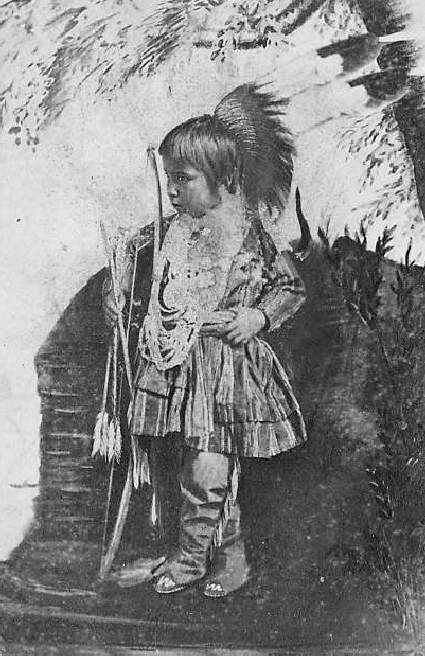
Native American Tribes: The Sioux--Clothing

Figure 1.-- This albumen CDV of Ma-za-oo-nie (Little Bird Hunter) was probably taken about 1870. The photographer was Whitney of St. Paul, Minnesota. The boy's hair was adorned with a hair roach and he holds a toy bow and arrow. It was taken for sale in the East where Americans were becoming interested in Native Americans. As a result he is dressed more elaborately that would be common for most children. A reader writes, "The light-coloured hair makes this boy looks more European with a fancy dress." Our reader is correct that a Native American boy should have black hair. This is not a high-quality image, so we are not sure how accuately the color of the hair is depicted. The photgrapher was located in Minnesota. It would not have been difficult for him to find Ntive American subjects.
|
|
Sioux clothing was primarily made from bufalo and deer leather. Furs were useful for winter wear. They had to trade for cloth fabric. Sioux clothing was varied. wore a variety of different kinds of clothing. Men and women dressed differently. The men wore shirts, leggings, breechcloths, and moccasins. The shirts and leggings were commonly made of deerskin which was more pliable than bufalo leather. Clothing was highly seasonal. The warriors when hunting byfalo during the summer commonly wore only a leather breechcloth (simple strip of leather) and moccasins. Accessories might include a knife sheath and a small bag for items like facepaint was held on from a leather belt. Women wore long leather dresses and leggings. The clothing worn for every day was very plain and utilitarian. There were clothes worn for special occassions. The Sioux had highly decorated clothing for special occasions. Decorations included beads, porcupine quills, and feathers. Styling was very ditinctive and tribes and sub-groubs could be identified by the clothing. The decorative clothing was worn fofr both war and ceremonies. The Sioux made dyes from local plants. These were used for painting designs on clothing. THese decorations might tell tribal tales. The chiefs had feather headdress, but only wore them for special occassions. Eagle feathers were the most prised. They were tipped with horsehair and fastened to a long strips of leather that trailed behinf. Women were more modest headwear. They commonly braided strips of leather into their hair. There was no destinctive clothing for children. They essentially wore the same clothing as their parents, only suitavkt scaked down. scaled down. The children until about 7 years of age went naked most of the time, especially during the warm summer seaon. This might also be the case during the Winter when they were in the teepees. Older boys wore breechcloths. In cool weather they wore shirts, leggings, and moccasins. Girls wore dresses, leggings, and moccasins. An old Sioux Woman reported that the younger children tended to view clothing as something disturbing. [Hassrick] The principal cold weather winter item was the buffalo robe. Men, women, and children wore them.
Sources
Hassrick, Royal B. The Sioux. Life and Customs of a Warrior Society (University of Oklahoma Press. 1964).
HBC

Navigate the Boys' Historical Clothing Web Site:
[Return to the Main Sioux pahe]
[Introduction]
[Activities]
[Art]
[Biographies]
[Chronology]
[Clothing styles]
[Countries]
[Bibliographies]
[Contributions]
[FAQs]
[Glossaries]
[Images]
[Links]
[Registration]
[Tools]
[Boys' Clothing Home]
Navigate the Boys' Historical Clothing ethnic pages:
[Return to the Main North American Native American cultural area page]
[Return to the Main North American Native American ethnic page]
[Return to the Main ethnic page]
[German]
[Greek]
[Irish]
[Scottish]
Navigate the Boys' Historical Clothing Native American pages:
[Ethnic]
[Dance]
Created: 4:29 PM 12/28/2008
Last updated: 3:03 PM 12/29/2008



